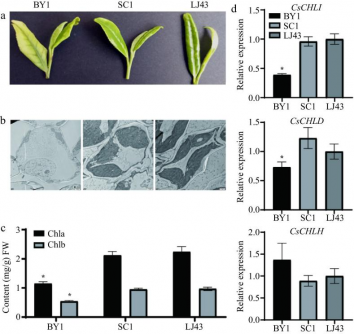A groundbreaking discovery in agricultural science is reshaping our understanding of tea plant genetics, particularly concerning the vibrant green coloration and overall quality of one of the world’s most beloved beverages. Researchers have pinpointed a crucial gene, CsCHLI, as a pivotal player in the complex process of chlorophyll biosynthesis, offering unprecedented insights into how tea leaves develop their characteristic hue and flavor profiles.
While the lush green of tea leaves is synonymous with vitality and economic value, certain esteemed albino or etiolated cultivars, such as ‘Baiye 1’, paradoxically possess exceptional flavor due to their high amino acid content, despite their pale appearance. This unique characteristic, however, comes at the cost of significantly reduced chlorophyll levels, which diminishes their market appeal and photosynthetic efficiency. Scientists have long suspected that these visual discrepancies are rooted in specific genetic alterations impacting chlorophyll metabolism.
At the heart of this intricate process lies the magnesium chelatase enzyme complex, which initiates the very first committed step in chlorophyll synthesis. Understanding the precise functions and interactions of its subunits is paramount to deciphering the sophisticated mechanisms governing tea leaf pigmentation. The recent investigation into CsCHLI, a key subunit of this vital enzyme, has significantly advanced our knowledge in this critical area.
To meticulously unravel the role of CsCHLI in tea leaf chlorophyll production, researchers employed a comprehensive suite of molecular, structural, and functional analyses. Their initial assessments involved scrutinizing leaf ultrastructure, chlorophyll content, and gene expression across both albino and green tea varieties. Transmission electron microscopy revealed striking differences in albino leaves, which displayed fewer chloroplasts with disrupted thylakoid structures and a notable absence of starch granules, correlating directly with their pale appearance. Furthermore, precise measurements confirmed significantly lower levels of chlorophyll a and b in the albino cultivars compared to their green counterparts.
Further molecular investigations through RT-qPCR dramatically highlighted a pronounced decline in CsCHLI expression within the pale leaves, strongly implicating its indispensable role in optimal chlorophyll production. To fully characterize this essential gene, the complete sequence of CsCHLI was meticulously cloned and analyzed. This revealed a precisely structured gene encoding a 424-amino acid protein, complete with conserved ATPase domains, including the critical Walker A/B and sensor motifs, all vital for robust Mg²⁺-chelatase activity. Phylogenetic analysis strategically positioned CsCHLI within the dicot clade, showcasing its close evolutionary relationship to Actinidia chinensis and underscoring its broad evolutionary conservation across diverse plant species.
Delving deeper into its cellular dynamics, subcellular localization experiments utilizing CsCHLI-EYFP fusion constructs unequivocally demonstrated that CsCHLI specifically targets the chloroplasts, the primary sites of photosynthesis in plant cells. Moreover, cutting-edge protein-protein interaction studies, employing both yeast two-hybrid (Y2H) and bimolecular fluorescence complementation (BiFC) assays, unveiled fascinating insights. These studies revealed CsCHLI’s remarkable capacity to form homodimers and, crucially, to interact seamlessly with other subunits of the magnesium chelatase complex, forming an integral part of this essential enzymatic machinery.
The ultimate confirmation of CsCHLI’s vital function came from rigorous functional validation experiments conducted in Arabidopsis thaliana. Here, the strategic overexpression of CsCHLI within a chlorophyll-deficient atchli1 mutant successfully initiated a partial rescue of the yellow-leaf phenotype, remarkably restoring normal chlorophyll levels while maintaining correct chloroplast localization. Collectively, these compelling findings conclusively affirm that CsCHLI is an indispensable component of the Mg²⁺-chelatase complex, fundamentally crucial for robust chlorophyll biosynthesis in tea plants. Its dysfunction is now clearly identified as a primary underlying cause of albinism observed in specific elite tea cultivars.
This pioneering study not only provides a definitive genetic explanation for the albino phenotypes characteristic of valuable tea cultivars but also strategically identifies CsCHLI as an exceptionally promising target for advanced molecular plant breeding. By precisely manipulating this gene, agricultural scientists can unlock the potential to develop innovative tea varieties boasting optimized pigment profiles, significantly enhanced photosynthetic capacity, and distinct, desirable flavor properties, ultimately elevating the economic value and consumer appeal of tea globally. Beyond the realm of tea, these profound findings offer significant potential for improving chlorophyll metabolism and enhancing agricultural productivity across a wider array of crop species, especially under environmental stress conditions that typically impede pigment synthesis.






Leave a Reply